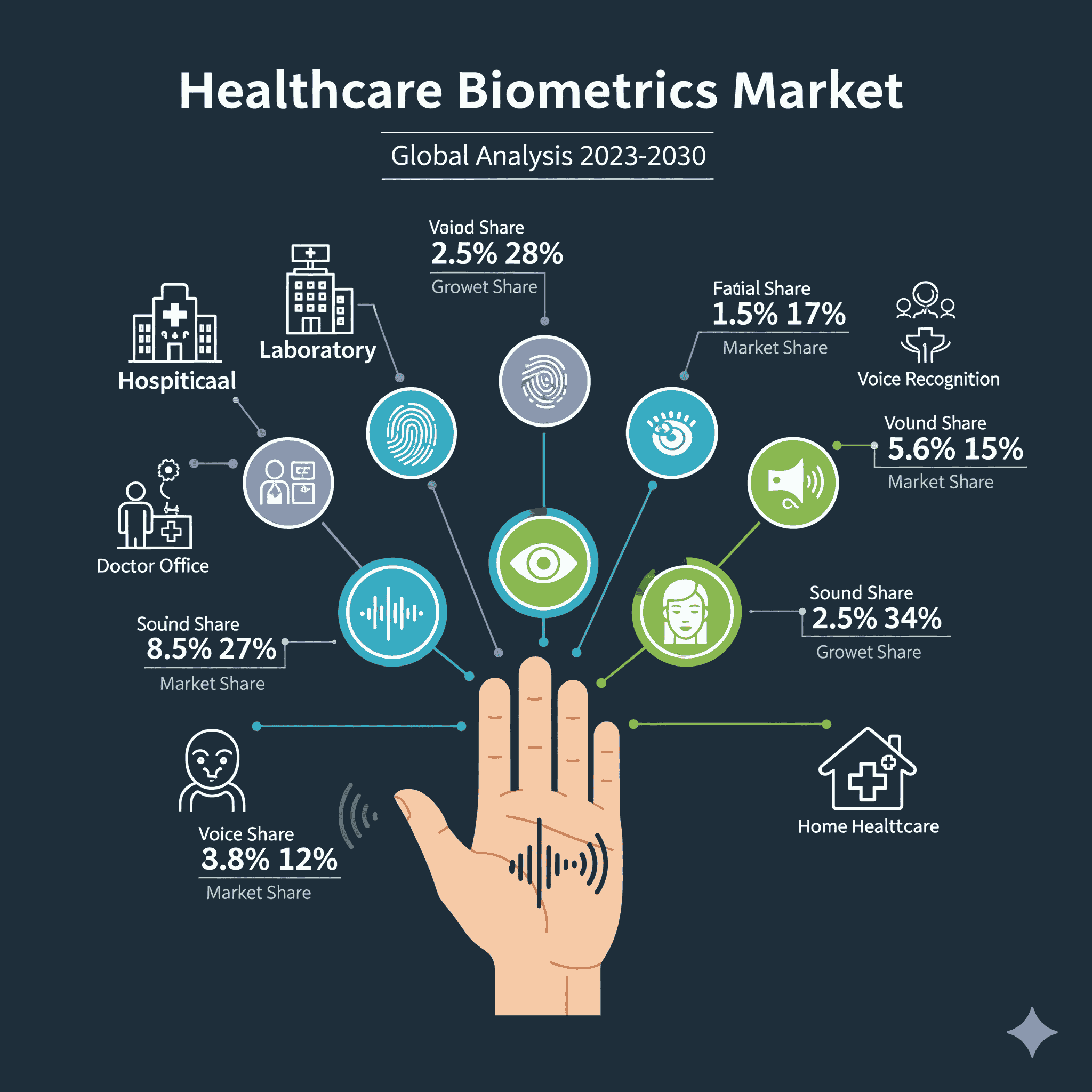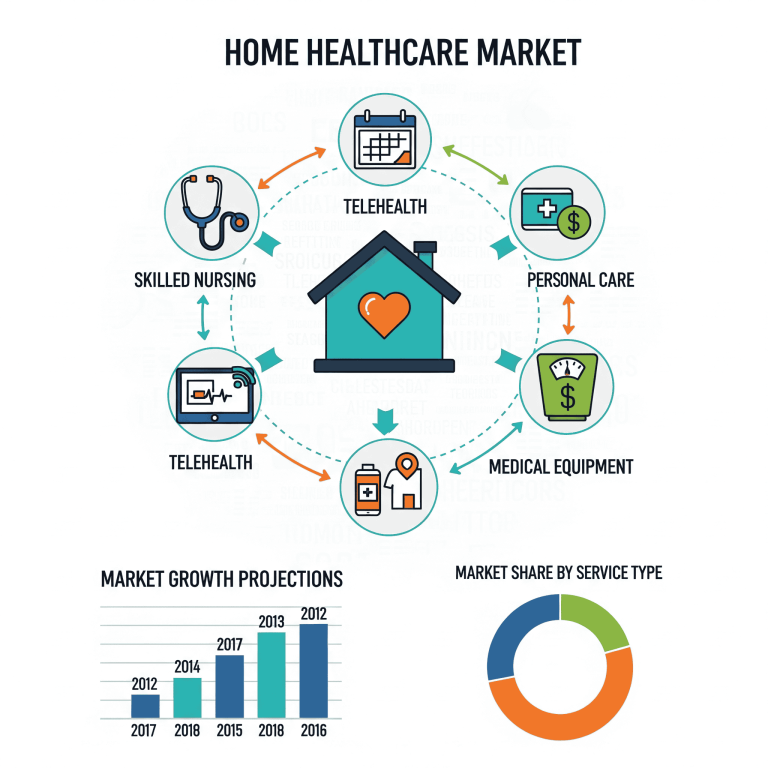
The global healthcare biometrics market was valued at USD 8.4 billion in 2024, projected to reach USD 9.86 billion in 2025 and further grow to USD 41.38 billion by 2034, expanding at a robust CAGR of 17.34% (2025–2034), driven by rising demand for secure patient identification, EHR authentication, and fraud prevention.
Download this Free Sample Now and Get the Complete Report and Insights of this Market Easily @ https://www.towardshealthcare.com/download-sample/6048
Market Size
◉2024 Market Size → USD 8.4 billion
◉2025 Market Size → USD 9.86 billion
◉2034 Market Size (Forecast) → USD 41.38 billion
◉CAGR (2025–2034) → 17.34%
Regional Share (2024):
◉North America → 42% (largest)
◉Asia Pacific → Fastest CAGR (accelerated adoption in digital health & smart hospitals)
Market Share by End User (2024):
◉Hospitals & Health Systems → 52% (largest revenue share)
Deployment Mode (2024):
◉On-premises/Enterprise → 58% (largest share)
Biometric Type (2024):
◉Fingerprint Recognition → 30% (dominant)
Market Trends
Rising Demand for Secure Authentication
◉Increase in medical data breaches → hospitals adopting biometrics for secure patient data.
◉Example: Change Healthcare cyberattack (April 2024) pushed rapid adoption.
Integration with Digital Health
◉Growth of EHR (Electronic Health Records) and HIS integration drives demand.
◉HER/HIS integration is the largest and fastest-growing segment.
Telemedicine & Remote Healthcare Expansion
◉Biometric verification for virtual patient care and remote monitoring.
◉Example: Imprivata (Feb 2024) launched Biometric Patient Identity (facial recognition) for hospitals.
AI-Enabled Biometrics
◉Smarter, anti-spoofing recognition algorithms improving system reliability.
◉Example: BIO-key International (Jan 2025) AI-powered biometric authentication system.
Shift Toward Non-Contact Biometrics
◉Facial and palm vein recognition gaining traction due to hygiene and convenience.
Software & Algorithms Domination
◉46% revenue share in 2024, due to scalability, integration with cloud, and multi-modal capabilities.
Regional Adoption Gaps
◉North America leads with early adoption.
◉Asia Pacific growing fastest due to smart hospitals & government initiatives.
Role of AI in Healthcare Biometrics
1. Improved Accuracy & Speed
◉Deep Learning Models: CNNs (Convolutional Neural Networks) used in facial recognition to detect subtle feature variations.
◉False Match/Reject Rate Reduction: AI algorithms optimize thresholds dynamically based on patient demographics.
◉Clinical Impact: Faster patient authentication at admission desks → reduces wait times.
◉Example: NEC’s AI facial engine achieving >99% accuracy in real-world hospital settings (2024 trials).
2. Adaptive Recognition (Dynamic Biometric Profiles)
◉Problem: Patient identifiers change (aging, injuries, weight fluctuations, facial hair, surgical scars).
◉AI Solution: Continuous retraining of biometric models → adaptive learning without re-enrollment.
◉Healthcare Use Case: Long-term patients in oncology/geriatric care maintain reliable biometric identities.
◉Trend: AI-driven “progressive enrollment” → system updates the template after every interaction.
3. Predictive Security & Fraud Detection
◉AI Analytics: Detects unusual biometric usage (e.g., login from two hospitals in different cities within an hour).
◉Insurance & Billing: Prevents duplicate patient identities, ghost claims, or fraudulent prescription pickups.
◉Threat Intelligence: AI integrates with IAM systems to flag insider misuse (staff credential sharing).
◉Example: U.S. insurers piloting AI biometric verification in claims processing (2025 rollouts).
4. Real-Time Integration with EHR/HIS
◉Challenge: EHR systems are massive, with latency risks.
◉AI Role: Parallel processing + fuzzy matching algorithms → instant cross-checking with millions of records.
◉Outcome: Clinicians get real-time patient identity confirmation during check-in, lab testing, or imaging.
◉Impact: Reduces medical errors caused by patient misidentification.
5. Scalable Cloud Integration
◉AI Advantage: Distributed machine learning enables multi-hospital biometric networks.
◉Example: A hospital chain can authenticate a patient across 20 branches in milliseconds.
◉Security Layer: Federated learning ensures models improve across sites without sharing raw biometric data (GDPR/HIPAA compliance).
◉Future: Cloud AI + blockchain for tamper-proof biometric audit trails.
6. Remote Patient Monitoring & Telemedicine
◉Voice Biometrics: AI analyzes pitch, tone, breathing irregularities for both authentication + health signals (e.g., respiratory stress).
◉Behavioral Biometrics: Keystroke dynamics & touchscreen patterns used in mental health monitoring apps.
◉Telehealth Security: AI ensures that the patient logging in remotely is the real person, not a proxy.
◉Example: AI-enhanced biometric authentication in schizophrenia monitoring devices (Athelas, 2024).
7. AI in Contactless Biometrics
◉Palm Vein Recognition: AI enhances vein pattern matching, even if blood flow varies (cold hands, dehydration).
◉Iris Recognition: Deep learning improves accuracy under poor lighting or partial occlusion (masks, glasses).
◉Facial Recognition: AI compensates for masks, PPE, and changing hospital lighting conditions.
◉Future Trend: AI-driven 3D biometrics (structured light, depth sensing) replacing 2D image-based systems.
8. Continuous Authentication & Ambient Monitoring
◉Beyond one-time login: AI monitors ongoing presence of the authenticated user (useful in telehealth, ICU access).
◉Methods: Passive face scans via camera, gait monitoring in hospital corridors.
◉Benefit: Reduces risk if a session/device is hijacked mid-use.
9. Personalization of Healthcare Using Biometrics + AI
◉Linking Biometrics & Health Data: AI can correlate biometric changes (voice stress, gait instability) with clinical deterioration.
◉Example: Voice biometrics used not just for login, but to flag Parkinson’s or depression.
◉Future Possibility: “Dual-purpose biometrics” → authentication + diagnostic insight.
10. Ethical & Regulatory Layer (AI Governance in Biometrics)
◉Bias Reduction: AI models being tuned for racial, gender, and age inclusivity.
◉Explainability: Hospitals need AI decisions to be auditable (why was a patient rejected?).
◉Compliance: HIPAA, GDPR, and India’s Digital Personal Data Protection Act (2023) shaping AI biometrics frameworks.
Regional Insights

1 North America (42% Market Share in 2024)
◉North America dominated the global healthcare biometrics market in 2024 due to early digital transformation in healthcare and regulatory emphasis on patient data protection.
Drivers
◉Strong EHR adoption across hospitals and clinics.
◉Cybersecurity compliance regulations (HIPAA, HITECH) mandate secure patient identity management.
◉High healthcare IT investments enable rapid deployment of biometric solutions.
U.S. Market
◉Growing demand for contactless authentication (face, iris, and palm recognition).
◉Integration of biometrics into mobile health apps for seamless patient experience.
◉Presence of leading biometric companies (Imprivata, BIO-key, NEC partnerships).
Canada Market
◉Focus on reducing medical identity fraud and duplicate patient records.
◉Expanding adoption of fingerprint and facial recognition in public health programs.
◉Government initiatives support EHR standardization with biometric integration.
2 Asia-Pacific (Fastest CAGR, 2025–2034)
◉Asia-Pacific is projected to grow at the fastest rate, driven by smart hospital initiatives, digital health investments, and rapid adoption of contactless identity systems.
China
◉Government-led smart hospital programs promoting biometric security.
◉Adoption of facial and vein recognition systems for patient check-ins.
◉Rising patient volumes drive hospitals to adopt workflow automation biometrics.
India
◉Large patient population creates a need for accurate identification systems.
◉Strong push from government digital health initiatives (e.g., Ayushman Bharat Digital Mission).
◉Demand for touchless biometric authentication in private and multi-specialty hospitals.
Japan & South Korea
◉Advanced hospital infrastructure integrates iris recognition and multimodal systems.
◉Emphasis on AI-powered biometrics for elderly care and chronic disease monitoring.
◉Early adoption of robotics + biometric integration in clinical workflows.
3 Europe (Strong Growth Forecast)
◉Europe is witnessing consistent growth due to strict compliance regulations and rapid adoption of digital health records.
UK
◉Wide adoption of biometrics for telemedicine, fraud reduction, and patient safety.
◉Supported by NHS digital transformation initiatives.
◉Hospitals are using facial recognition kiosks for faster patient check-in.
Germany
◉Investment in smart hospitals drives biometric deployment in multiple departments.
◉Preference for touchless authentication methods to reduce errors.
◉Integration of EHR and HIS with biometric verification enhances efficiency.
France, Italy, Spain
◉Adoption driven by EU-wide data protection regulations (GDPR).
◉Hospitals focusing on secure authentication for cross-border health programs.
◉Growth in cloud-based biometrics to link regional hospital networks.
4 Middle East & Africa (Emerging Market)
◉MEA is an emerging region with strong pilot projects in biometric healthcare systems.
UAE
◉Amazon + ICP collaboration (March 2025): Palm vein + facial biometrics for healthcare check-ins and payments.
◉Rapid adoption in smart hospitals and government healthcare programs.
Saudi Arabia
◉Investments in next-generation hospitals under Vision 2030.
◉Biometric solutions deployed for patient identity management and access control.
5 Latin America (Moderate Growth)
◉Adoption is moderate due to infrastructure challenges but rising demand in public health programs.
Brazil & Mexico
◉Increasing biometric use in government-led health ID programs.
◉Focus on fraud prevention in insurance claims.
◉Adoption of fingerprint and multimodal systems in urban hospitals.
Market Dynamics
Drivers
◉Rising cases of data breaches and fraud risks push hospitals to adopt secure biometrics.
◉Example: Change Healthcare cyberattack (April 2024) exposed vulnerabilities, triggering rapid biometric adoption.
◉Growing reliance on EHRs and telemedicine platforms requires secure patient authentication.
Restraints
◉High implementation costs for biometric hardware (scanners, sensors, cameras).
◉Ongoing maintenance and software updates add to operational costs.
◉Smaller facilities hesitate due to integration complexity and IT staff requirements.
Opportunities
◉Expansion in telemedicine & remote patient monitoring.
◉Biometric systems for virtual identity verification and remote medication dispensing.
◉Example: Athelas Clozapine monitoring (Nov 2024) → Biometric-enabled device for schizophrenia patients improved remote care and safety.
Top Companies

Imprivata
◉Product: Biometric Patient Identity (facial recognition, launched Feb 2024).
◉Strengths: Market leader in clinical authentication; trusted by large hospitals; strong focus on EHR integration.
IDEMIA
◉Product: Multimodal biometric solutions (face, iris, fingerprint).
◉Strengths: Global reach; expertise in government + healthcare identity management systems.
NEC Corporation
◉Product: Face detection tech deployed in U.S. hospitals (Feb 2025).
◉Strengths: Advanced AI-driven facial recognition, real-time identity verification.
Thales / Gemalto
◉Product: Digital ID & healthcare authentication systems.
◉Strengths: Leading global provider of secure ID & encryption technologies; trusted for compliance-heavy healthcare markets.
HID Global
◉Product: Access control & biometric ID solutions.
◉Strengths: Specializes in secure digital platforms and hospital identity ecosystems.
Fujitsu
◉Product: Palm vein recognition systems.
◉Strengths: Pioneer in non-contact biometric authentication; widely used in Asia-Pacific healthcare.
BIO-key International
◉Product: AI-powered authentication system (Jan 2025).
◉Strengths: Affordable fingerprint-based systems; strong adoption in U.S. hospitals.
Latest Announcement
Amazon (March 2025)
◉Rolled out palm-vein biometric payment & patient check-in system.
◉Collaboration with UAE’s Federal Authority for Identity, Citizenship, Customs and Port Security (ICP) and local banks.
◉System links palm vein + facial data for multi-purpose authentication.
◉Goal: reduce waiting times at hospital front desks and ensure secure identity validation across financial and healthcare systems.
Recent Developments
NEC Corporation (Feb 2025)
◉Partnered with a major U.S. healthcare provider to implement face detection check-in systems.
◉Aim: streamline hospital workflows, reduce administrative burden, and ensure secure patient identity verification.
MoHAP, Dubai (Jan 2025, Arab Health Event)
◉Introduced a facial scanning smartphone system for quick health diagnostics.
◉Measures: cholesterol, hemoglobin, heart rate, blood pressure, and stress levels.
◉Significance: moves biometrics beyond identification → into real-time health monitoring.





